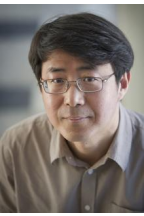Bae-Yeun Ha

Biography
In Professor Ha's research group, they explore a few theoretical problems in soft matter and biophysics, namely, chromosomes in living cells and lipid bilayer membranes.
Research Interests
Biomaterials, Polymers and Bioplastics
Biochemistry and Biophysics
Soft Matter
Physiology, Cell and Developmental Biology
Theoretical molecular biophysics & soft matter
Polymer physics for chromosome organization in a cell
Confined polymers: chain topology, spatial organization, & dynamics
Electrostatics in soft matter and biomolecules
Electrostatic modification of lipid membranes
Physical basis for cell selectivity of antimicrobial peptides
Scholarly Research
Education
1996, Doctorate Physics, University of Maryland, College Park, Maryland, U.S.A.
1986, Master of Science Physics, Korea University, Seoul, Korea
1985, Bachelor of Science (BS) Physics, Korea University, Seoul, Korea
Affiliations and Volunteer Work
Centre for Bioengineering and Biotechnology
Teaching*
- PHYS 225 - Modeling Life Physics
- Taught in 2020, 2021, 2022, 2024, 2025
- PHYS 242 - Electricity and Magnetism 1
- Taught in 2022, 2025
- PHYS 365 - Mathematical Physics 2
- Taught in 2021, 2022
- PHYS 380 - Molecular and Cellular Biophysics
- Taught in 2022, 2025
- PHYS 491 - Special Topics in Life, Medical and Biophysics
- Taught in 2022
* Only courses taught in the past 5 years are displayed.
Selected/Recent Publications
Bae-Yeun Ha and Youngkyun Jung. "Polymers under confinement: single polymers, how they interact, and as model chromosomes". Soft Matter, 2015, 11, 2333-2352
Juin Kim, Chanil Jeon, Hawoong Jeong, Youngkyun Jung and Bae-Yeun Ha. "A polymer in a crowded and confined space: effects of crowder size and poly-dispersity". Soft Matter, 2015, 11, 1877-1888
Chanil Jeon, Juin Kim, Hawoong Jeong, Youngkyun Jung and Bae-Yeun Ha. "Chromosome-like organization of an asymmetrical ring polymer confined in a cylindrical space". Soft Matter, 2015, 11, 8179-8193
Azadeh Bagheri, Sattar Taheri-Araghi, and Bae-Yeun Ha. "How Cell Concentrations Are Implicated in Cell Selectivity of Antimicrobial Peptides". Langmuir, 2015, 31 (29), pp 8052–8062.
Please see Pubfacts for a complete list of Dr. Ha's publications.